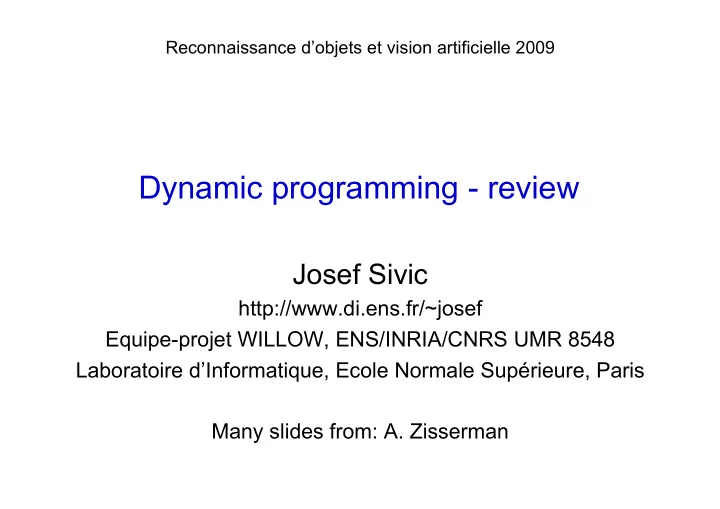

Reconnaissance d’objets et vision artificielle 2009 Dynamic programming - review Josef Sivic http://www.di.ens.fr/~josef Equipe-projet WILLOW, ENS/INRIA/CNRS UMR 8548 Laboratoire d’Informatique, Ecole Normale Supérieure, Paris Many slides from: A. Zisserman
Dynamic programming • Discrete optimization • Each variable x has a finite number of possible states • Applies to problems that can be decomposed into a sequence of stages • Each stage expressed in terms of results of fixed number of previous stages • The cost function need not be convex • The name “dynamic” is historical • Also called the “Viterbi” algorithm
Consider a cost function of the form where x i can take one of h values trellis x 1 x 2 x 3 x 4 x 5 x 6 e.g. h=5, n=6 find shortest path Complexity of minimization: • exhaustive search O(h n ) • dynamic programming O(nh 2 )
Example 1 smoothness closeness to measurements d x i i
Motivation: complexity of stereo correspondence Objective: compute horizontal displacement for matches between left and right images
x 1 x 2 x 3 x 4 x 5 x 6 Key idea: the optimization can be broken down into n sub-optimizations
x 1 x 2 x 3 x 4 x 5 x 6
Viterbi Algorithm Complexity O(nh 2 )
Example 2 d x i i Note, f(x) is not convex
Note This type of cost function often arises in MAP estimation measurements Bayes’ rule e.g. for Gaussian measurement errors, and first order smoothness Use negative log to obtain a cost function of the form from likelihood from prior
Where can DP be applied? Dynamic programming can be applied when there is a linear ordering on the cost function (so that partial minimizations can be computed). Example Applications: 1. Text processing: String edit distance 2. Speech recognition: Dynamic time warping 3. Computer vision: Stereo correspondence 4. Image manipulation: Image re-targeting 5. Bioinformatics: Gene alignment
Application I: string edit distance The edit distance of two strings, s1 and s2, is the minimum number of single character mutations required to change s1 into s2, where a mutation is one of: 1. substitute a letter ( kat cat ) cost = 1 2. insert a letter ( ct cat ) cost = 1 3. delete a letter ( caat cat ) cost = 1 Example: d( opimizateon, optimization ) op imizateon || ||||||||| optimization |||||||||||| ‘c’ = copy, cost = 0 cciccccccscc d(s1,s2) = 2
Complexity • for two strings of length m and n, exhaustive search has complexity O( 3 m+n ) • dynamic programming reduces this to O( mn )
Using string edit distance for spelling correction 1. Check if word w is in the dictionary D 2. If it is not, then find the word x in D that minimizes d(w, x) 3. Suggest x as the corrected spelling for w Note: step 2 appears to require computing the edit distance to all words in D, but this is not required at run time because edit distance is a metric, and this allows efficient search.
Application II: Dynamic Time Warp (DTW) Objective: temporal alignment of a sample and template speech pattern sample template audio time frequency (Hz) warp to match log(STFT) `columns’ of log(STFT) matrix short term Fourier transform
template Application II: Dynamic Time Warp (DTW) s a m p l e is time shift of i th column (1, 0) (0, 1) quality of match cost of allowed moves (1, 1)
Application III: stereo correspondence Objective: compute horizontal displacement for matches between left and right images
Application III: stereo correspondence Objective: compute horizontal displacement for matches between left and right images is spatial shift of i th pixel quality of match uniqueness, smoothness
left image band right image band 1 normalized cross 0.5 correlation(NCC) 0 x NCC of square image regions at offset (disparity) x
• Arrange the raster intensities on two sides of a grid • Crossed dashed lines represent potential correspondences • Curve shows DP solution for shortest path (with cost computed from f(x))
Pentagon example left image right image range map
Real-time application – Background substitution Left view Right view Input Results Background substitution 2 Background substitution 1 input left view
Application IV: image re-targeting • Remove image “seams” for imperceptible aspect ratio change seam Seam Carving for Content-Aware Image Retargeting. Avidan and Shamir, SIGGRAPH, San-Diego, 2007
scale seam removal
Finding the optimal seam – s s
Generalization: dynamic programming on graphs 1 2 3 4 5 6
Different graph structures 6 1 3 5 2 3 2 3 1 2 1 4 5 4 6 4 5 6 Fully connected Tree structure Star structure O(nh 2 ) O(nh 2 ) O(h n ) Application: fitting pictorial structures to images
Recommend
More recommend